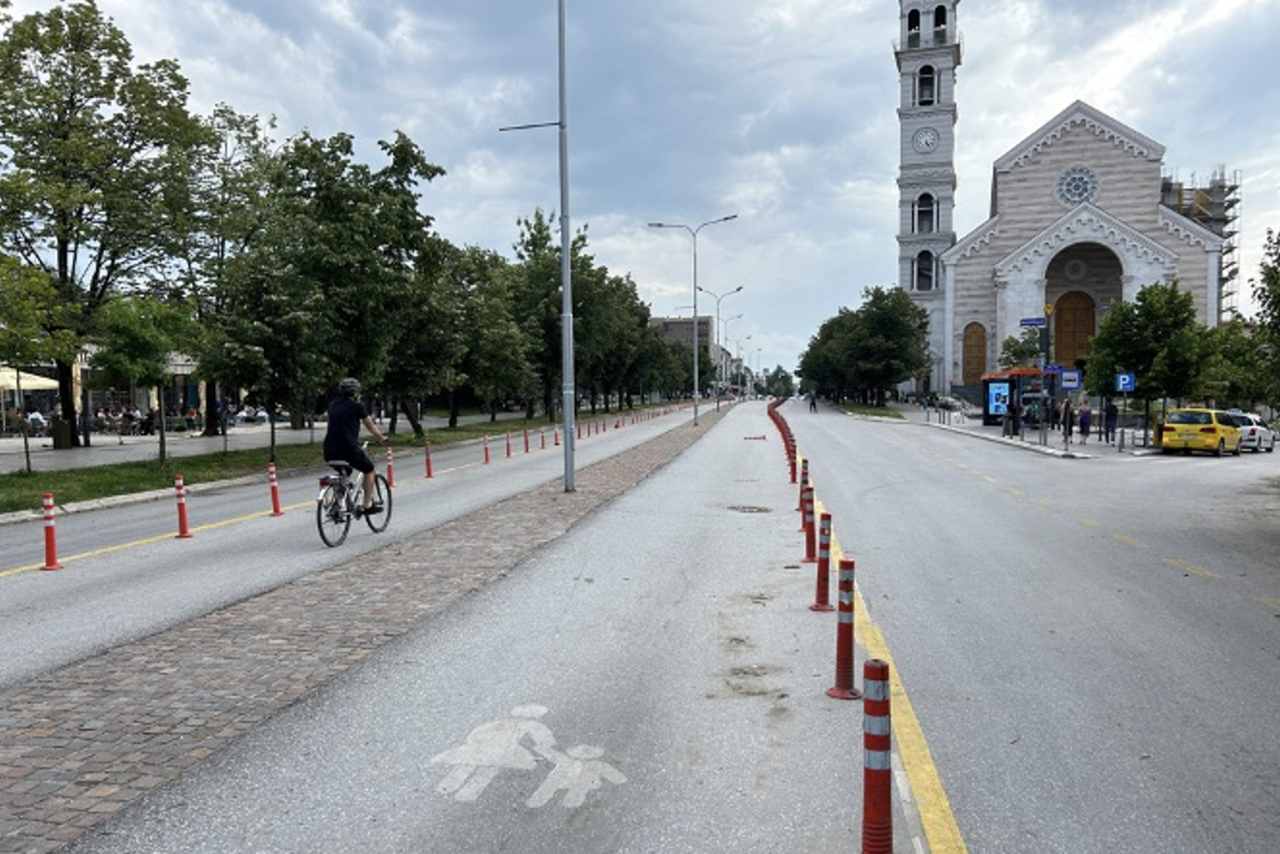For European Mobility Week, towns and cities are rallying efforts and ideas for improving shared public space. We typically think of public space as ‘shared’ when it effectively meets the needs of all, or at least as many as possible, groups living and using the public space. While this might seem logical and fair, today’s reality is quite different. Most public spaces serve the purpose of transport (effectively, the needs of commuters going to work). There are other administrative, political and logistical obstacles to shared public space. Nevertheless, this has not always been the case, nor does it have to dictate cities of the future.
Can we make urban spaces that truly belong to everyone? Let’s take inventory of sustainable mobility actions across different generations, cities, regions and sectors in an effort to rediscover and repurpose shared public space.
A walk through the history of shared public space
To promote shared public space in the future, we first need to go back to the past, when carriages, cyclists, but mainly pedestrians, were all using the same space. Only with the advent of motorisation, and mainly cars, did space become separated and segmented according to use. In turn, active modes of mobility – other than cars – were either taken out or pushed to the very edges of the city design.
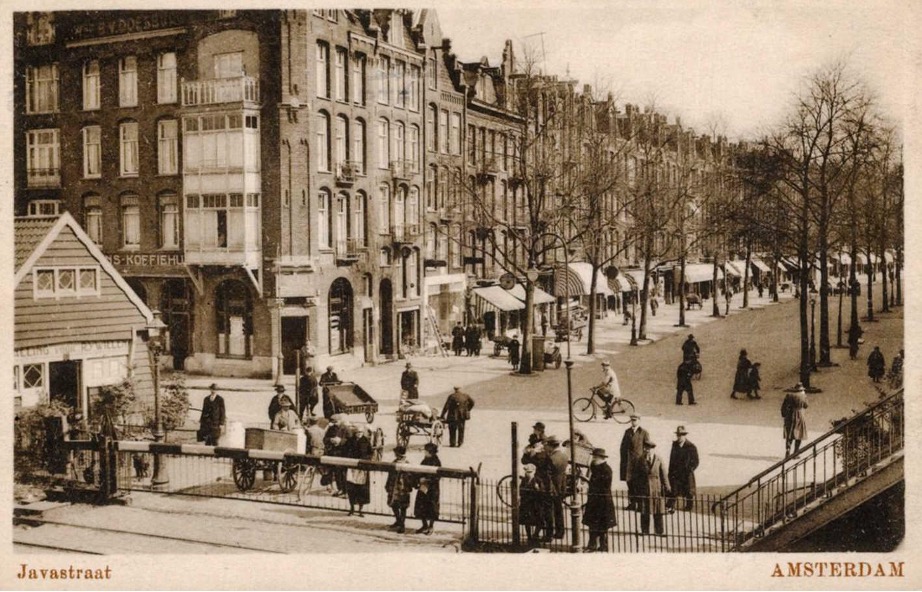
Jaavastreet in Amsterdam. Source: wikipedia.
Starting in the 1980s, the idea of ‘shared spaces’ reappeared in the Netherlands. A road engineer by the name of Hans Monderman wanted to reduce traffic speed. His plan proved that roads can be public spaces for everyone, without ‘removing’ pedestrians or other users. Thus, the idea to redesign streets and crossings without lanes, traffic signs or lights took hold. In rural areas, for example, we have seen that this approach can revive and enrich the central areas of towns and villages – from a car space to a space for people.
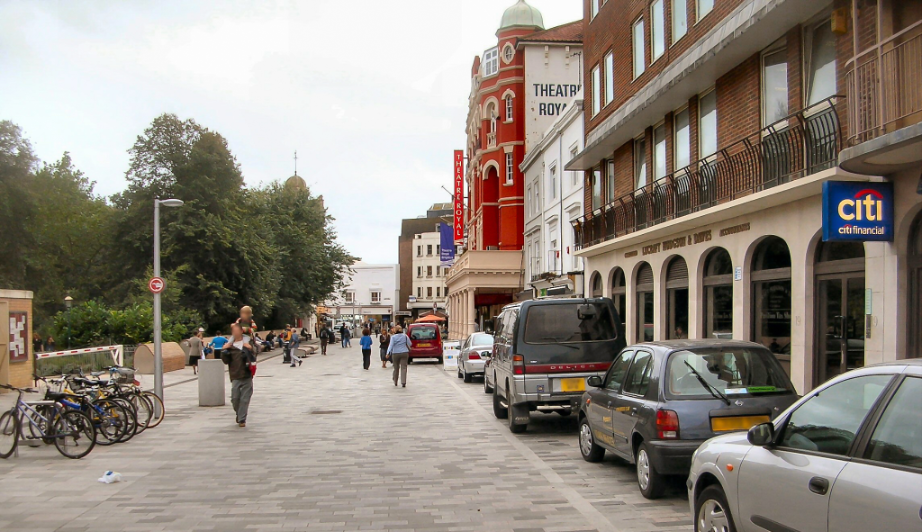
New Road in Brighton. Source: wikipedia.
Looking beyond the street: a shift in mobility practices
Today, traditional private car-dominated streets are being transformed into areas that prioritise walking, cycling and public transport, while still accommodating car use. The transformation of car streets into shared public spaces through mobility projects depends on a broader shift in mobility practices, reducing reliance on private cars in favour of more sustainable alternatives. These more sustainable modes of transport not only lower environmental impacts but also strengthens the social function of public spaces. In this way, mobility becomes a tool for fostering human interaction and community life, even as cities face increasingly extreme weather conditions due to climate change. Enlarging the space for non-motorists also supports people with reduced mobility (e.g. wheelchair users, visually impaired persons but as well parents pushing a pram requires dedicated space). Applying a universal design principle to public space that caters for the needs of vulnerable user groups is to the benefit of all in the end.
In addition, the 15-minute city has emerged as possibly the most prominent concept. Related to this is the necessity for new approaches to urban mobility that are multimodal and digitally connected (i.e. mobility-as-a-service). This requires not only physical infrastructure but also digital solutions that enable people to plan trips and access transportation services in real time.
Regardless of these genuine ambitions, this process is complex and requires strong political support, public engagement and the integration of multiple stakeholders. The transformation calls for a collaborative and forward-thinking approach to create cities that are truly sustainable, accessible and equitable for future generations.
The following section exposes some of these methods adopted in cities throughout Europe to improve the liveability of public space.
Rethinking the mobility space in terms of shared public spaces
Bernardgasse: community-led street redesign for comprehensive mobility
Urban mobility projects often face resistance from residents and local businesses, particularly when they involve reducing car traffic or other potential inconveniences. Therefore, it is essential to engage the local community early in the planning process and provide opportunities for participation and feedback throughout the project’s development. In successful examples, such as the redesign of Bernardgasse, a rather short neighbourhood street in the 7th district of Vienna, continuous communication with the public helped to ensure that changes met residents' needs while fostering a sense of ownership over the transformation.
In Bernardgasse, the street redesign involved not only physical changes to the streetscape but also a comprehensive mobility survey and an innovative mobility concept developed in collaboration with local stakeholders. The goal was to guide residents towards more sustainable mobility choices while simultaneously improving the quality of the public space. This experience affirms the importance of coordinating the efforts of various stakeholders, from urban planners, landscape architects and local authorities to residents and business owners, in order to achieve a successful and sustainable transformation. The shared space in the Bernardgasse also highlights how reducing car traffic – all 140 car parking spots were replaced by green areas and wider sidewalks – can lead to improvements in environmental quality, such as reduced noise and emissions. By adopting a holistic approach that combines infrastructure improvements, behaviour change, and political leadership, cities can create public spaces that are not only more liveable but also better equipped to meet the needs of a growing urban population.
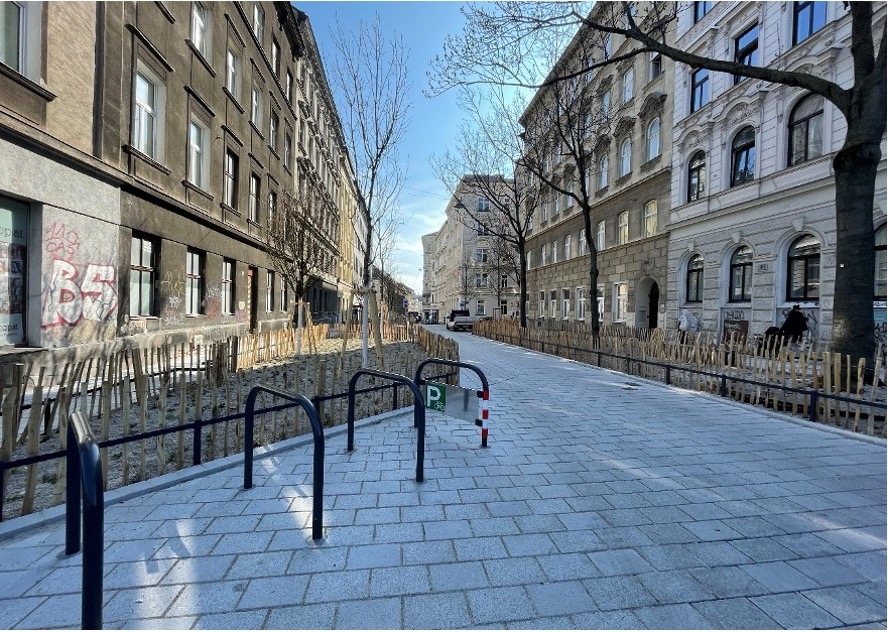
The newly implemented shared space of the Bernardgasse in Vienna, Austria. Source: Roland Krebs.
Ennis: finding a middle ground between commercial and social urban life
Many smaller towns and cities often have just one main arterial road. The main road is essential to the social and economic functions of town centres, so closing it off could threaten commercial streets. Ennis (IE) is currently transforming the medieval town’s urban core into shared public spaces. While cars can still pass through the town, pedestrians now enjoy wider sidewalks and more relaxing public areas. Ennis is a partner in URBACT’s ECONNECTING Action Planning Network, which focuses on smart mobility solutions that strengthen urban-rural linkages. The Network aims to enhance regional mobility while regenerating small public spaces to create welcoming environments for residents.
Ennis’s shared space approach was a politically bold decision, which sparked some controversy. But in the end, it has provided a middle ground, helping to calm traffic and create more enjoyable public areas for people of all ages while keeping people coming into the towns and their centres.
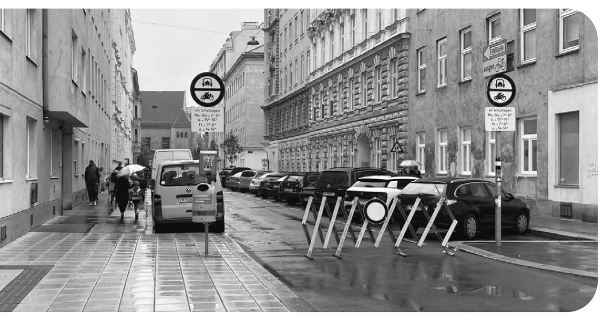
Traffic sign announcing a School Street regulation in Vienna, Austria. Source: Roland Krebs.
Bolzano: making the best use of streets for children
Children are often underrepresented in planning processes or planners’ considerations. Consequently, roads and traffic are not aligned to their needs, as visible in the pile of cars arriving at lessons’ start and end at the school building creating a range of problems for the pupils. School Streets are an easy and effective answer to this that reflects the needs of different user groups (like parents and pupils) and arranges road use respectively.
The concept of School Streets originated in Bolzano (IT) back in 1989. A School Street stops motorised traffic from entering a school access road about 15-30 minutes around classes’ start (and end) time. The investment needed, and additional costs, for a removable barrier to close the access road is quite low; yet, the effects is worth every cent: road injuries go down dramatically as do air and noise pollution in the school environment. Pupils feel encouraged to walk, cycle or scoot to the benefit of their physical and mental development, which both require movement in the light of the World Health Organization’s definition on health enhancing physical activity (60 min a day for children).
This idea has spread throughout Italy to cities like Parma (IT). A partner of the URBACT SCHOOLHOODS Action Planning Network, Parma has more than 20 school streets in action.
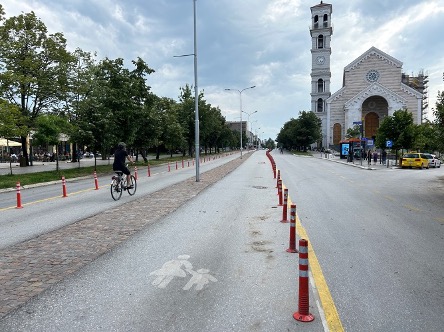
Tactical Urbanism to test actions in real time experiments in Pristina, Kosovo. Source: Roland Krebs.
Turku: tactical urbanism is an easy start
Shared public spaces schemes like encounter zones, classical shared spaces, as well as play streets and school or home zones, often meet initial resistance. The emergence of tactical urbanism in urban planning is a good option to overcome opposition by demonstrating the benefits to the respective local communities affected by the change.
The summer street in Turku (FI), another SCHOOLHOODS partner, is a good example for tests as a planning tool. For a three-month period, motorised traffic was restricted from an inner-city street. A case study from the EU Urban Mobility Observatory provides more insights on the impact of this action.
Umeå and Trikala: mobility for gender-equal cities
Umeå (SE) and Trikala (EL) have worked together to further mobility for public space initiatives through URBACT’s GenderedLandscape Action Planning Network. Umeå is a lighthouse example for integrating gender equality to urban development. One of its most known achievements is the creation of the FRIZON park. The park was designed for – and with the involvement of – young girls. Today, the park remains a free zone for persons who identify as female to linger and meet friends.
Trikala developed the ‘inclusive school yard’. The action focuses on children assessing the school yard, the first public social space for children, through the lens of equality and gender. Stated simply, it presents a new design that reflects boys and girls needs alike.
The way forward: claiming space for everyone
When it comes to shared public space, European cities have made necessary strides forward, but also backward. Looking at the work of URBACT cities and Networks, as well as the dynamics of gender, disability, and rural-urban mobility in today’s cities, the two URBACT Action Planning Networks, ECONNECTING and SCHOOHOODs, exemplify how this knowledge is translated into practical work by our partner cities, allowing other partners to benefit from these firsthand experiences.
Are you on the move? Read more about URBACT’s expert insights and activities around mobility:
Have a look at the URBACT Walk’n’Roll Cities Guidebook for mobility and public space planning with more ideas for small-, mid- and large-sized cities.
Discover a wealth of articles and updates on the URBACT Mobility Knowledge Hub.
This article was authored by: Claus Köllinger and Roland Krebs.

